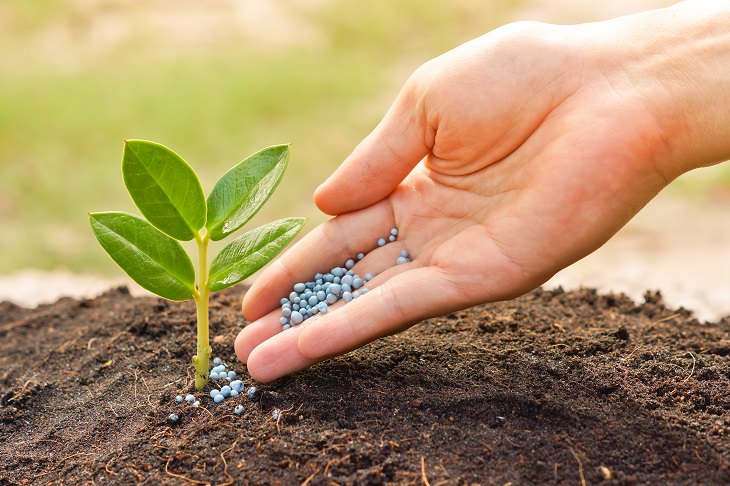

Many people believe that the more they water their plants, the better they will be. However, all plants (including non-potted plants) have different watering needs and these needs may vary depending on the time of year or season, the amount of light and ambient temperature. The best way to avoid this problem is to know the moisture level that each plant requires. The majority of plants (except moisture loving plants) love it when the top surface of the soil dries out between watering spells, while others require the soil to be slightly moist at all times. A good method to use is to poke your finger into the soil about an inch deep and feel if its wet or dry.
2. Underwatering
It’s just as harmful to under-water plants. Therefore, once again, it is important to know the moisture requirements of each plant to keep them healthy. Also, it’s obvious that in the summer plants will require more water. When you’re watering your plants, do it thoroughly, so that the entire substrate moistens well and some water seeps out from the holes at the bottom of the pot. Wait for it to dry, and then water again.
3. You Do Not Know Everything About the Plant
No two plants are the same. The number one thing you should do is to ask about the growing requirements of a plant before you purchase one. Furthermore, you should do some of your own research on your new plant when you get home. There are many great gardening websites available that have excellent information on a wide range of plants.

It’s often thought that all plants love the sun, but there are some that require shade or partial shade. According to experts, the plants themselves can tell us if they are getting the right amount of light or not. For example, the leaves may change color or become scorched if they’re getting too much sunlight. On the other hand, if the plant is stretching toward the light or the leaves are a lot bigger than usual, then they need more light.
5. Moving or Changing Positions of Plants
Plants get used to the location they have been placed, and do not like being moved about constantly. If one of your plants is thriving under certain temperatures and conditions, avoid moving it, as it may be difficult for the plant to adapt to its new place.
6. Incorrect Soil
Every plant species has its own planting needs and soil requirements. Therefore, it’s recommended that you do proper research regarding soil type before potting your plant. If you are placing a plant in a container, be sure to use well-draining soil. You can make your own light and crumbly soil mixture, or can buy some from your local garden store.

Some of the common pests that can affect your potted plants are aphids, spider mites, scales, mealybugs, and whiteflies. Attacks from these pests can be prevented with some simple techniques. Whenever you buy a new plant, analyze it to see if there are any signs of pests or disease. Look on the undersides of the leaves and the tips of the plants as these are the parts that pests like to infect the most. If pests are already damaging your plants, identify what type of pests they are, and then treat them appropriately.
8. No Transplanting
Most plants will outgrow their containers after a year or two, so it’s very important that you transplant them into larger containers with fresh and well-nourished potting soil. Some of the signs that indicate that it’s time to transplant is when the leaves turn yellow, the plant stops growing, or seems to require water again and again.
9. Carelessness
Are you going on vacation? This might be good for you, but it isn’t for your potted plants. Therefore, you must make sure to make arrangements for them. Ask someone to come in and water the plants when you’re away. Another option is to use self-watering containers.
10. No Pinching, Deadheading, and Pruning
If you want bushier growth, pinch the tips of young plants. Furthermore, many flowering plants require “deadheading,” which means picking and removing the old flowers to promote new ones. You will know when to remove them once the flowers start to fade or wilt or turn brownish.

Potted plants depend heavily on soil nutrients and can often require supplements to grow better, improving the production of flowers and fruits. If you use a balanced fertilizer, regularly and according to the instructions, you can ensure that your plants are getting all the nutrients that they require.
12. Over-fertilization
Over-fertilization can also be detrimental to your plants. It can even kill them. Fertilizers, when used in excess, can cause a lot of damage to the roots. If you see symptoms such as yellowing and wilting of the lower leaves, browning leaf tips, defoliation, and slow or no growth, then it is possible that your plant is suffering from over-fertilization.
13. Exposing to Extreme Temperatures
If you do your research on your plants, you will find out what temperature (maximum or minimum) they can tolerate. During harsh winters, it is best to protect your plants by keeping them indoors or in a greenhouse. If you’re living in a warm climate where summers get hot, protect your plants from the intense summer sun using a tarp.
Source: balconygardenweb
Images: depositphotos